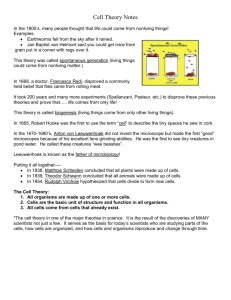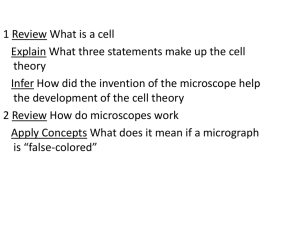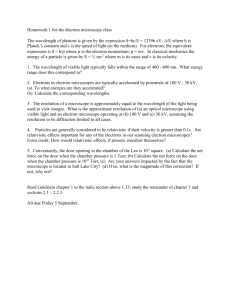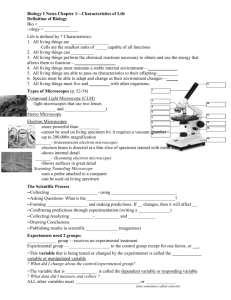Unit 4: Microscopes, Cells, Tree of Life
advertisement
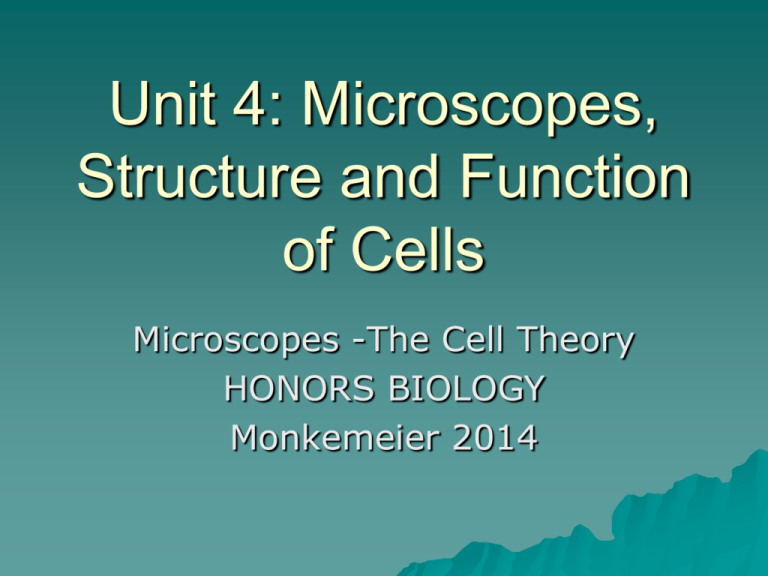
Unit 4: Microscopes, Structure and Function of Cells Microscopes -The Cell Theory HONORS BIOLOGY Monkemeier 2014 History of Knowledge 1665: 1673: 1833: 1855: 1857: 1897: Robert Hooke van Leeuwenhoek Schleiden and Schwann Virchow Discovery of Mitochondria Discovery of Golgi Apparatus Timeline of Events in Perspective The Cell Theory All living things are composed of one or more cells. The cell is the basic unit of structure and function of organisms. Cells come from the reproduction of preexisting cells. Microscopes 1590:Zacharias Jansen and the first compound microscope Their first microscopes were more of a novelty than a scientific tool since maximum magnification was only around 9x and the images were somewhat blurry. Van Leeuwenhoek Anton van Leeuwenhoek (16321723), a Dutch draper and scientist, and one of the pioneers of microscopy who in the late 17th century became the first man to make and use a real microscope. First to view Protists, Bacteria, Plants, Yeast. Modern Microscopes Compound Light Microscope Scanning Electron Microscope Transmission Electron Microscope Resolving Power –the ability of the microscope to produce separate images of two closely spaced objects. Produce clear, crisp image Magnification – the enlargement of the image. Microscope Comparison The Resolving Power of a microscope is limited by the wavelength radiation used to view the sample. Light used in microscopes has a wavelength of 400 – 600 nanometers. Increased resolution requires smaller wavelength. Beam of electrons used in electron microscopes has a wavelength of less than 1 nanometer! WHY does Wavelength of Radiation Matter? Refraction The beam of electrons will not have as much refraction as visible light. Refraction is the bending of “light” as it passes through a lens (moves from one medium to another) Comparison of Microscopes: Light Uses beam of visible light to produce image. Image produced is true to color as the original specimen. Specimen can be live. Can magnify up to 1000x Can see cells. Comparison of Microscopes – Transmission Electron Microscope Uses a beam of electrons to produce image. Image produced is called micrograph and it is in black and white. Can magnify up to 200,000x Specimen must be sliced extremely thin. Distortion can occur due to this. Can see cross-sectional area. Can see organelles. TEM Comparison of Microscopes: Scanning Electron Microscope Uses a beam of electrons to produce image. Image produced is a threedimensional surface view. Image produced is black and white Can magnify up to 100,000 x Specimen must be coated with gold and placed in a vacuum. SEM Your Turn Use your notes to construct a chart which compares Compound Light Microscopes to Transmission Electron Microscopes and Scanning Electron Microscopes! Comparison Chart Microscope Compound Light Microscope Transmission Electron Microscope Scanning Electron Microscope Source of Image Type of image Magnification Preparation of Specimen Special Concerns Limitations


